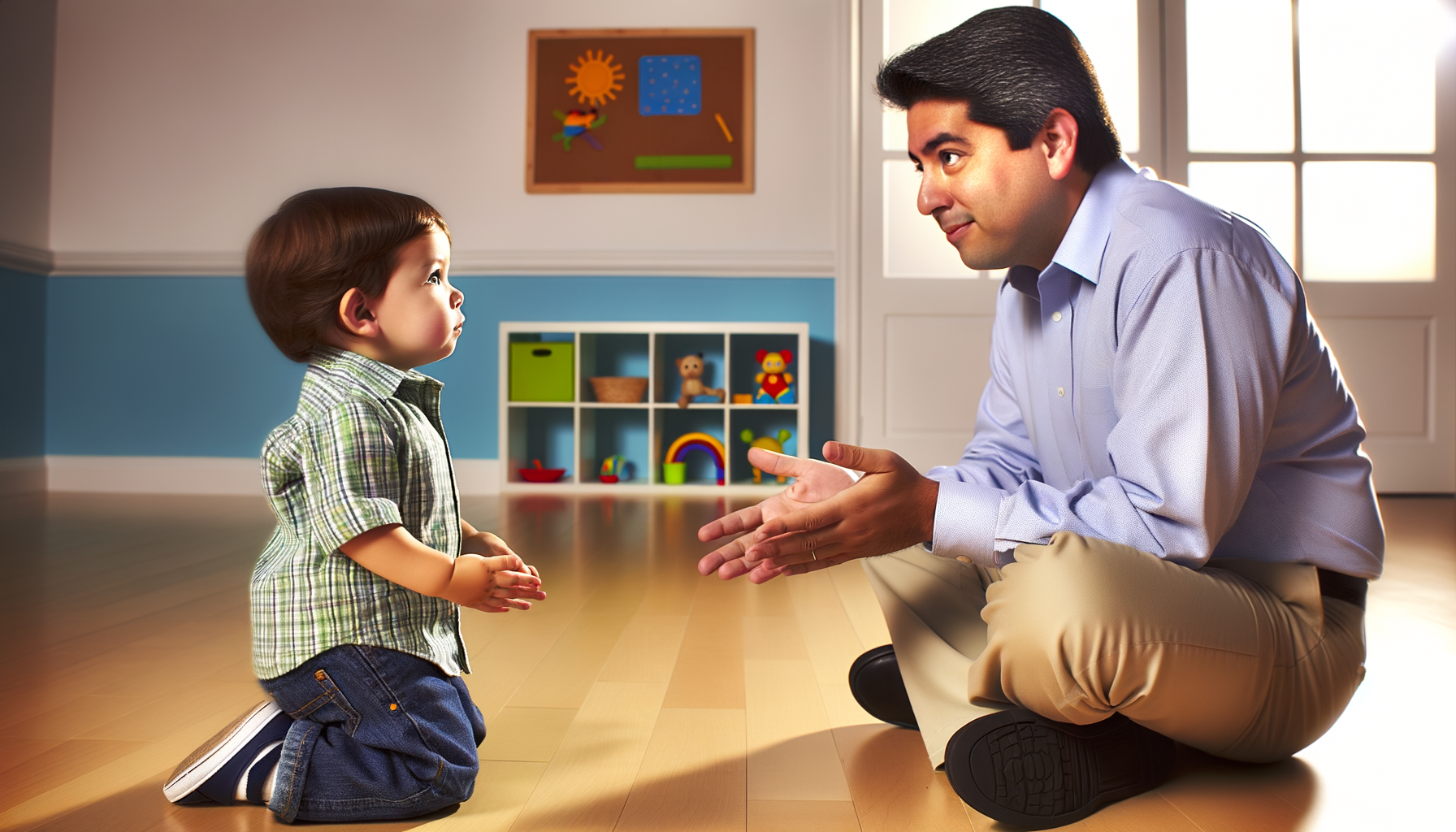Introduction
Understanding Toddler Communication
Communication with toddlers is a multifaceted process that extends beyond the mere exchange of words. It encompasses both verbal and nonverbal interactions, such as the pitch and tone of voice, facial expressions, and body language. Toddlers are keen observers and often pick up on the subtleties of communication, which can include everything from eye contact to the emotional undertones carried by a hug or a smile. As they develop, toddlers begin to understand and use language, but they also rely heavily on nonverbal cues to interpret the world around them and express their own needs and feelings.
Importance of Effective Communication with Toddlers
Effective communication with toddlers is crucial for their emotional and social development. It helps to build a strong bond between parent and child, fostering a sense of security and trust. By engaging in meaningful conversations and responding to their attempts at communication, parents encourage their toddlers to express themselves and develop their language skills. This interaction is not only about responding to their needs but also about guiding their behavior and helping them understand the complex social cues of their environment.
How Language Development Affects Behavior
The progression of language development in toddlers is closely linked to their behavioral patterns. As toddlers acquire language, they become better equipped to express their desires, frustrations, and emotions in a constructive manner, often leading to a decrease in tantrums and other challenging behaviors. Language provides toddlers with the tools to negotiate, solve problems, and understand the concept of rules and boundaries. Moreover, the ability to communicate effectively is integral to their ability to form relationships with peers and adults outside of their immediate family.
In summary, the journey of mastering communication is a critical aspect of a toddler’s growth. By understanding the nuances of how toddlers communicate, recognizing the importance of nurturing these skills, and acknowledging the impact of language development on behavior, parents and caregivers can create a supportive environment that promotes healthy development and lays the foundation for lifelong learning and social interaction.
Phrase 1: Positive Reinforcement
Examples of Positive Reinforcement Phrases
Positive reinforcement is a powerful tool in shaping a toddler’s behavior. By acknowledging and praising desired actions, we encourage our little ones to repeat them. Here are some phrases that can serve as positive reinforcement:
- “Great job sharing your toys with your friend!” – This reinforces the value of sharing.
- “I love how you used your words to express what you need.” – This encourages verbal communication.
- “You put your shoes on all by yourself; that’s amazing!” – This celebrates independence.
- “Thank you for helping me clean up; you’re such a good helper.” – This appreciates cooperation.
- “I noticed you were really patient while waiting.” – This acknowledges the virtue of patience.
The Impact of Positive Words on Toddler Behavior
Using positive words to reinforce good behavior has a profound impact on a toddler’s development. When we acknowledge positive actions with specific praise, we not only boost their self-esteem but also reinforce the behavior we want to see more of. This approach aligns with the principles of operant conditioning, where behaviors followed by positive outcomes are more likely to be repeated.
Moreover, positive reinforcement contributes to a safe and supportive environment where toddlers feel valued and understood. This nurturing atmosphere is crucial for healthy emotional and social development. By focusing on what toddlers do well, rather than on their mistakes, we foster a growth mindset that encourages them to try new things and persist in the face of challenges.
It’s important to note that the effectiveness of positive reinforcement is maximized when it is immediate and consistent. Toddlers live in the moment, and timely praise helps them make clear connections between their actions and our positive response. Consistency in our reactions assures them that the rules of their world are stable and predictable, which is essential for their sense of security.
In conclusion, incorporating key phrases of positive reinforcement into daily interactions with toddlers can lead to a harmonious relationship and promote desirable behaviors. By doing so, we lay the groundwork for our children to develop into confident, capable, and emotionally intelligent individuals.
Phrase 2: Expressing Understanding
Phrases to Show Empathy and Understanding
Communicating with toddlers requires a delicate balance of clarity and empathy. When they experience strong emotions or face challenges, it’s crucial to express understanding. Phrases like “I see you’re upset, and that’s okay” or “It’s hard when we can’t have what we want right away” validate their feelings. By acknowledging their emotions, you’re not only showing that you understand, but you’re also teaching them to recognize and name their feelings. Other empathetic phrases include:
- “You’re really trying hard, and I’m proud of you.”
- “That was disappointing, wasn’t it?”
- “You seem frustrated; do you need help?”
Using these phrases helps toddlers feel heard and supported, which can reduce tantrums and build trust.
Building Emotional Intelligence in Toddlers
Emotional intelligence is the ability to understand and manage one’s own emotions, as well as empathize with others. For toddlers, the foundation of emotional intelligence is built through interactions with caregivers. When you use phrases that express understanding, you’re not only comforting your child but also teaching them valuable lessons about emotions.
For instance, saying “I can tell you’re angry, but we don’t hit. Let’s use our words or take deep breaths instead” helps toddlers learn to cope with anger in a healthy way. Similarly, “You’re sad because your toy broke. It’s okay to feel sad. Let’s see if we can fix it together” teaches problem-solving alongside emotional regulation.
By consistently using language that models empathy and emotional understanding, you encourage your toddler to develop these skills themselves. This can lead to better self-awareness, greater empathy for others, and improved relationships throughout their life. Remember, the goal is not to dismiss or fix their feelings but to acknowledge and guide them through their emotional experiences.
In conclusion, the phrases we use with our toddlers can significantly impact their emotional development. By expressing understanding and showing empathy, we foster an environment where toddlers feel safe to express themselves and learn to navigate their emotions. This, in turn, lays the groundwork for strong emotional intelligence as they grow.
Phrase 3: Setting Boundaries
Clear and Kind Ways to Set Limits
Setting boundaries with toddlers is a delicate balance between guiding them and providing a sense of security. It’s essential to establish limits with clarity and kindness. A clear boundary might be, “We hold hands when we cross the street.” This statement is direct and leaves no room for ambiguity. However, the tone in which it is delivered should be gentle and reassuring, not harsh or punitive. When setting limits, it’s also helpful to explain the reason behind them, which can be as simple as, “Holding hands keeps us safe from the cars.” Involving children in the process can also be effective. For instance, asking, “What should we remember to do when we cross the street?” prompts them to think about safety and the established boundaries.
Another strategy is to use positive language to frame the boundaries. Instead of saying, “Don’t run in the house,” you can say, “We walk inside to keep safe.” This not only sets the boundary but also encourages the behavior you want to see. Consistency is key; once a limit is set, it’s crucial to stick to it. If a rule is broken, calmly restate the boundary and guide your toddler back to the desired behavior.
Why Consistency Matters in Boundary-Setting
Consistency in boundary-setting is vital for toddlers as it helps them understand what is expected of them. When boundaries are enforced consistently, toddlers learn to trust and feel secure in their environment. Inconsistent boundaries, on the other hand, can lead to confusion and anxiety, as toddlers are unsure of what is allowed and what isn’t. Consistency also teaches toddlers about consequences. If a boundary is crossed, such as a toy being thrown, the consistent consequence might be taking the toy away for a short period. This helps toddlers connect their actions with outcomes.
Parents and caregivers must present a united front when setting boundaries. If one parent allows a behavior that the other does not, it undermines the consistency and can lead to manipulation by the toddler. Consistency doesn’t mean there’s no room for flexibility; as children grow and situations change, boundaries may need to be adjusted. However, the core boundaries regarding safety, respect, and family rules should remain stable and consistently applied.
In conclusion, setting boundaries with toddlers requires clear communication, kindness, and unwavering consistency. By doing so, we provide a framework within which our toddlers can explore, learn, and grow safely.
Phrase 4: Encouraging Curiosity
Phrases to Foster Exploration and Learning
Curiosity is the engine that drives learning and development in toddlers. As parents and caregivers, we can stoke the fires of this curiosity with carefully chosen phrases that encourage exploration and discovery. Phrases like “What do you think will happen if…?” or “Let’s find out together!” invite toddlers to predict and explore outcomes. Asking open-ended questions such as, “What do you see?” or “Tell me more about this,” encourages toddlers to observe and articulate their thoughts. When a toddler shows interest in a new object or activity, responding with enthusiasm—“You’re a great explorer!” or “You noticed something new, let’s check it out!”—validates their inquisitive nature and supports their learning journey.
The Role of Curiosity in Cognitive Development
Curiosity is not just about asking questions; it’s a fundamental part of cognitive development. It leads to greater engagement with the environment and a deeper understanding of how the world works. When toddlers are encouraged to be curious, they develop critical thinking and problem-solving skills. Phrases that encourage curiosity also help toddlers to build vocabulary and improve their language skills as they learn to describe their discoveries and experiences.
Moreover, fostering curiosity can have long-term benefits. Toddlers who are encouraged to explore and ask questions may become more self-directed learners as they grow, always eager to learn new things. By using phrases that promote curiosity, we are not only engaging with our toddlers in the present but also setting them up for a lifetime of learning and discovery. For instance, when a child asks about the stars, a response like “The sky is full of wonders. Let’s learn about the stars together,” can spark an interest in astronomy that lasts a lifetime.
In conclusion, the phrases we use with our toddlers can significantly influence their willingness to explore and learn. By consciously incorporating phrases that encourage curiosity into our daily interactions, we can help our toddlers develop the cognitive skills they need to navigate and understand the world around them. It’s about creating a supportive environment where questions are welcomed, exploration is celebrated, and learning is a shared adventure.
Phrase 5: Offering Choices
How to Present Options to Toddlers
Presenting options to toddlers is a delicate art that involves clarity, simplicity, and patience. When offering choices, it’s crucial to ensure that the options are age-appropriate and understandable. For instance, instead of asking an open-ended question like “What do you want to drink?” you can provide specific alternatives such as “Would you like water or milk?” This not only simplifies the decision-making process for the toddler but also encourages them to use their words to express their preference.
When presenting choices, keep the number of options limited – usually two or three is sufficient. Too many choices can be overwhelming and may lead to indecision or frustration. Additionally, make sure the choices offered are acceptable to you as a parent. For example, if it’s cold outside, you might ask, “Do you want to wear your red sweater or your blue jacket?” rather than giving the option not to wear a warm layer at all.
Visual aids can also be helpful. Showing the actual items they can choose from can make it easier for toddlers to understand and make a decision. For example, holding up two shirts and asking which one they’d like to wear can be more effective than asking them verbally without the visual cue.
Empowering Toddlers Through Decision-Making
Empowering toddlers through decision-making is about more than just making daily routines smoother. It’s a fundamental part of their development, fostering independence and self-esteem. When toddlers make choices, they learn about consequences and begin to understand their own preferences and control over their environment.
By offering choices, you validate your toddler’s opinions and feelings, which is essential for their emotional development. It’s a way to show respect for their emerging autonomy and to help them feel heard and understood. For example, allowing a toddler to choose between two snacks gives them a sense of agency and can also reduce power struggles.
Decision-making also serves as an early lesson in problem-solving. Toddlers start to weigh options and consider outcomes, which are critical thinking skills that will benefit them throughout life. Moreover, making choices can help toddlers feel more invested in the task or activity at hand, leading to better cooperation and enthusiasm.
It’s important to praise your toddler for making decisions, which reinforces their ability to choose and boosts their confidence. Phrases like “Great choice!” or “You picked the green shirt, and it looks wonderful!” acknowledge their decision and encourage them to continue expressing their preferences.
In conclusion, offering choices to toddlers is a powerful communication tool that supports their growth and development. It teaches them to think independently, understand their emotions, and interact with the world around them in a meaningful way.
Phrase 6: Validating Feelings
Phrases That Acknowledge and Validate Emotions
Communicating with toddlers often requires a delicate balance of guidance and understanding. When it comes to emotions, toddlers are just beginning to learn how to express and manage them. As parents and caregivers, using phrases that acknowledge and validate their feelings can be incredibly powerful. Here are some phrases that can help:
- “I see you’re feeling (emotion). It’s okay to feel that way.” – This phrase acknowledges the child’s current emotional state and reassures them that it is normal to have such feelings.
- “You seem (emotion). Do you want to talk about it?” – This invites the child to share more about their feelings and shows that you are there to listen.
- “It’s hard when (situation).” – Empathizing with the child’s situation helps them feel understood and supported.
- “Let’s take a deep breath together.” – This provides a calming action that can help regulate emotions and demonstrates co-regulation.
- “Would you like a hug or some space?” – Offering comfort or respecting their need for space honors their feelings and autonomy.
The Importance of Emotional Validation for Healthy Development
Validating a toddler’s emotions is not just about making them feel better in the moment; it plays a crucial role in their overall emotional development. When children feel that their emotions are understood and accepted, they are more likely to develop a sense of security and self-worth. This validation teaches them that their feelings are important and that they are valued as individuals.
Emotional validation also helps toddlers learn to identify and label their emotions, which is a key component of emotional intelligence. By recognizing and naming their feelings, children can better communicate their needs and learn strategies for coping with intense emotions. This skill set is essential for navigating social interactions and building resilience against stress and adversity.
Moreover, when parents model empathetic communication, they set the stage for their children to develop empathy for others. Toddlers learn through observation and imitation, so when they see their caregivers responding to emotions with understanding and care, they are likely to mirror these behaviors in their own interactions.
In summary, using phrases that validate feelings not only soothes the child in the present but also lays the groundwork for a lifetime of healthy emotional processing and interpersonal relationships. By consistently acknowledging and validating our toddlers’ emotions, we empower them to grow into emotionally competent and compassionate individuals.
Remember, the goal is not to fix the emotion but to acknowledge it, provide support, and guide the child through their experience. This approach fosters a trusting relationship where the child feels safe to express themselves and learn from their emotional experiences.
Phrase 7: Encouraging Independence
Phrases to Promote Self-Reliance and Confidence
Encouraging independence in toddlers is a delicate balance between providing support and allowing them the space to explore their capabilities. Phrases that promote self-reliance and confidence are key in this developmental stage. Here are some examples:
- “You can try it first.” This phrase suggests that the child has the first opportunity to attempt a task before seeking help, fostering a sense of autonomy.
- “I believe in you.” Expressing belief in a child’s ability to accomplish something encourages them to trust in their own skills.
- “What’s your plan?” Asking a child to articulate their approach to a task encourages critical thinking and problem-solving.
- “It’s okay to make mistakes.” This reassures children that errors are a natural part of learning and that they have the resilience to overcome them.
- “I’m here if you need me.” While promoting independence, it’s important to let them know support is available, ensuring they don’t feel abandoned.
Balancing Guidance with Independence
While it’s important to encourage independence, toddlers still require guidance to navigate their world safely and effectively. Striking the right balance is crucial for their development. Here’s how to approach it:
- Offer limited choices. Provide options that are age-appropriate and safe, allowing the child to make decisions within a structured framework.
- Step back, but stay observant. Allow children the space to explore, but remain vigilant to step in when safety is a concern or when they exhibit signs of frustration.
- Encourage, don’t do. When a child struggles with a task, offer verbal encouragement or a hint rather than completing the task for them.
- Consistency is key. Consistently applying these strategies helps children understand what to expect and what is expected of them, which is essential for building independence.
By using phrases that promote self-reliance and confidence, and by balancing guidance with independence, parents can foster an environment where toddlers feel empowered to explore, learn, and grow into self-assured individuals.
Phrase 8: Teaching Gratitude
Phrases to Instill a Sense of Gratitude
Instilling a sense of gratitude in toddlers begins with the language we use around them. Simple phrases can lay the foundation for a lifelong appreciation of what they have and the people around them. Phrases such as “Thank you for helping me” or “I appreciate when you share your toys” demonstrate gratitude in action. When a child hears, “I’m grateful we have time to play together,” it teaches them to value shared experiences. Additionally, engaging in activities like creating a gratitude tree where family members add leaves with written notes of gratitude can make the concept tangible and fun.
The Long-Term Benefits of Raising a Grateful Child
Raising a child with a grateful mindset offers profound long-term benefits. Grateful children are likely to grow into adults who appreciate the good in their lives, rather than focusing on what they lack. This perspective can lead to increased happiness and resilience, as they are better equipped to cope with stress and adversity. Gratitude also fosters empathy and kindness, as children learn to recognize the effort of others. By teaching gratitude, we are not only enhancing our children’s emotional wellbeing but also contributing to the development of compassionate, content, and socially connected adults.
Encouraging children to express gratitude through thank-you notes, gratitude jars, or gratitude walks can be powerful tools. These activities help children to recognize and articulate the good in their lives, reinforcing the habit of seeking out and acknowledging positives. Moreover, gratitude practices such as these have been linked to better sleep, healthier relationships, and improved overall health. Thus, the simple act of teaching a toddler to say “thank you” and mean it can have ripple effects that extend far into their future.
In conclusion, the phrases we teach our toddlers can significantly influence their development of gratitude. By consistently modeling and encouraging expressions of thankfulness, we lay the groundwork for our children to become adults who lead happier, more fulfilling lives. The investment in teaching gratitude is one that pays dividends in the form of emotional and social wellbeing for years to come.
Phrase 9: Promoting Cooperation
Phrases to Encourage Teamwork and Helpfulness
Teaching toddlers the value of cooperation is a fundamental step in their social development. To encourage teamwork and helpfulness, use phrases that are simple yet powerful in conveying the message of unity and collaboration. Phrases like “Let’s work together on this” or “Can you help me with this task?” invite participation and create a sense of belonging. Emphasize the joy of shared success with words of affirmation such as “We did it together!” or “Look what we can achieve when we help each other!” By using language that promotes a collaborative spirit, you are laying the groundwork for your toddler to develop into a cooperative and considerate individual.
How Cooperation Skills Extend Beyond the Home
The ability to cooperate is not just a skill for home life; it has far-reaching implications for a child’s future interactions in various social settings. When toddlers learn to cooperate, they are acquiring a vital life skill that will benefit them in preschool, future workplaces, and in the broader community. Phrases that encourage teamwork and helpfulness at a young age can help children understand the importance of working with others to achieve common goals. This understanding fosters a sense of community and can lead to a more harmonious society. As they grow, children who have learned the value of cooperation are more likely to become adults who can collaborate effectively, resolve conflicts, and contribute positively to their communities.
In conclusion, the phrases we use with our toddlers can significantly influence their ability to work well with others. By consistently incorporating language that promotes cooperation, we are not only enhancing our immediate interactions with our children but also equipping them with essential skills for success in all areas of life.
Phrase 10: Cultivating Patience
Phrases to Teach and Reinforce Patience
Patience is a virtue that can be challenging to instill in toddlers, who naturally seek immediate gratification. However, with the right phrases and consistent reinforcement, parents can teach their toddlers the value of waiting and self-control. Phrases such as “Let’s wait a little longer, we can do this together,” or “I know it’s hard to wait, but you’re doing a great job!” can be powerful tools. These phrases acknowledge the difficulty of the task while also providing encouragement and support. Additionally, using countdowns like “Just five more minutes, can you count with me?” helps toddlers grasp the concept of time and the transient nature of waiting. It’s also beneficial to praise patience when you see it, with phrases like “You waited so nicely, thank you!” which reinforces the behavior you want to see.
The Virtue of Patience in Child Development
Patience is not just about waiting; it’s a fundamental component of emotional regulation and resilience. When toddlers learn patience, they are also learning how to handle frustration and delay gratification, skills that are critical for success later in life. The development of patience is linked to positive outcomes in academic performance, social relationships, and overall well-being. By teaching toddlers to be patient, parents are helping them to develop the ability to think ahead, set goals, and work steadily towards achieving them. Moreover, patient children are often better at cooperating with others and are more likely to become empathetic individuals. Thus, cultivating patience is about nurturing a child’s ability to thrive in a world where not everything can or should be instantaneous.
Conclusion
In conclusion, teaching and reinforcing patience in toddlers is a multifaceted endeavor that requires thoughtful communication and consistent practice. By using phrases that teach patience and acknowledging the effort it takes to wait, parents can foster this essential skill. The benefits of patience extend far beyond the toddler years, contributing to a child’s success and happiness throughout their life. As such, patience is not just a virtue but a cornerstone of healthy child development.
Conclusion
Recap of Key Phrases and Their Importance
Throughout this article, we have explored ten essential phrases that can significantly enhance communication with your toddler. These phrases are not just tools for effective conversation but are foundational elements in nurturing your child’s emotional and cognitive development. Let’s briefly recap these key phrases:
- Positive Reinforcement: Phrases that acknowledge and celebrate your child’s achievements and good behavior, fostering a sense of accomplishment and self-worth.
- Expressing Understanding: Phrases that show empathy and validate your child’s feelings, helping them develop emotional intelligence.
- Setting Boundaries: Clear and kind expressions that establish limits, teaching your child about safety and social norms.
- Encouraging Curiosity: Phrases that prompt exploration and inquiry, crucial for cognitive growth and learning.
- Offering Choices: Providing options to empower your child in making decisions, thereby boosting their independence and critical thinking skills.
- Validating Feelings: Acknowledging and affirming your child’s emotions, which is vital for their emotional health and resilience.
- Encouraging Independence: Words that promote self-reliance and confidence, preparing them for future challenges.
- Teaching Gratitude: Phrases that instill appreciation and thankfulness, contributing to a positive outlook on life.
- Promoting Cooperation: Encouraging teamwork and helpfulness, skills that are beneficial throughout life.
- Cultivating Patience: Teaching the value of waiting and self-control, an essential life skill.
Final Thoughts on Communication and Toddler Development
Effective communication with your toddler is about much more than just exchanging words. It involves active listening, empathy, and a deep understanding of your child’s developmental needs. By incorporating the key phrases discussed, you are not only enhancing your daily interactions but also laying the groundwork for your child’s future success in relationships, education, and personal growth.
Remember, each phrase carries the weight of emotional and cognitive influence, shaping your toddler’s self-esteem, social skills, and learning abilities. By being mindful of your language and the messages you convey, you are providing your child with the tools they need to navigate the world with confidence and curiosity.
In conclusion, the journey of parenting is enriched by the moments of connection we create with our children. By using these ten key phrases, you are building a bridge of understanding and love that will support your toddler’s journey into a well-rounded individual. Embrace these phrases, practice them daily, and watch as your toddler blossoms into a communicative, confident, and caring person.








